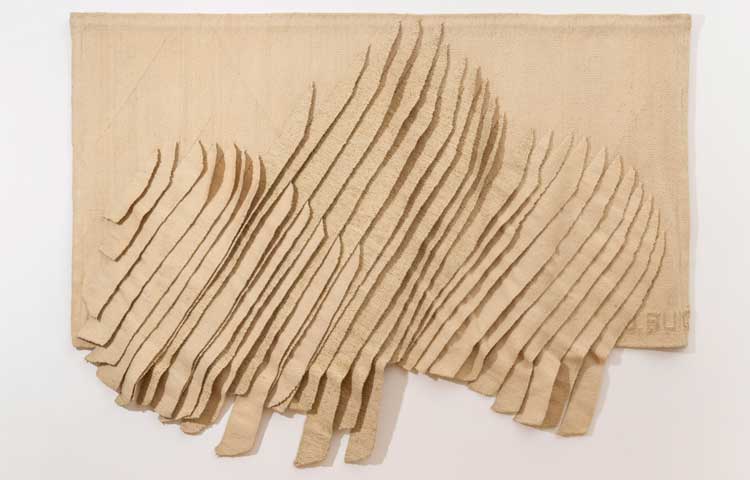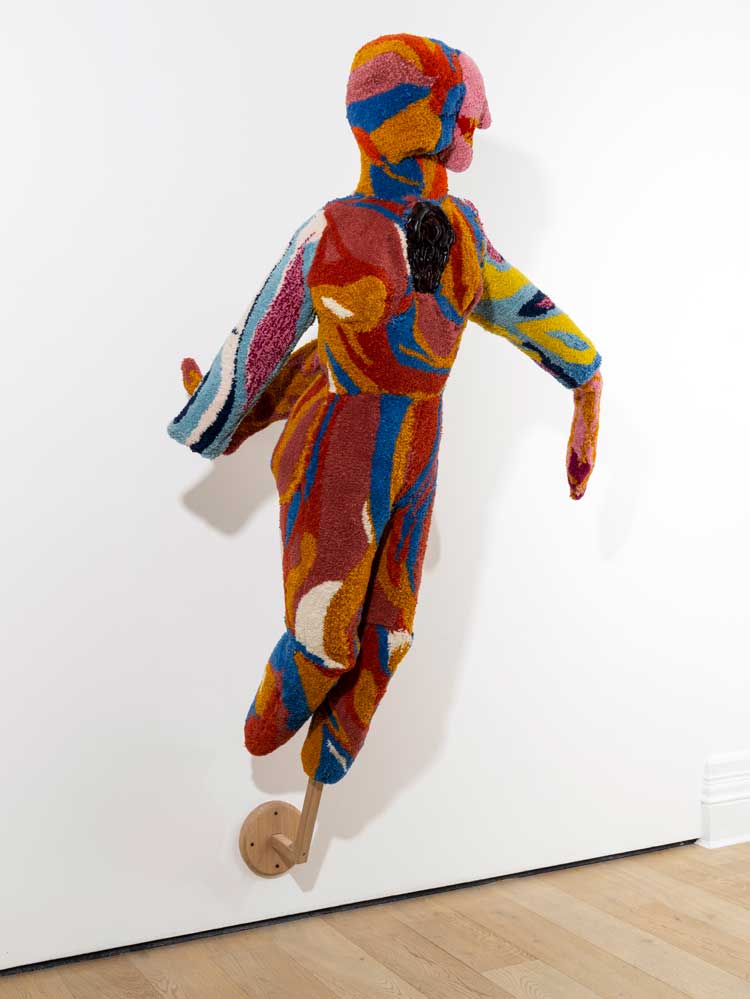
Antigone: Women in Fibre Art, installation view, Richard Saltoun Gallery London, 31 January - 18 March 2023. Courtesy Richard Saltoun Gallery.
Richard Saltoun Gallery, London
31 January – 18 March 2023
by BETH WILLIAMSON
With Magdalena Abakanowicz’s giant of an exhibition still at Tate Modern, this small show of women’s fibre art at Richard Saltoun Gallery is a welcome opportunity to see her work within the rich context of eastern European textile art tradition more broadly. While the exhibition focuses on the gallery artists Jagoda Buić and Barbara Levittoux-Świderska, other pioneers of the fibre art movement, such as Abakanowicz and Ewa Pachucka, feature along with new work from Anna Perach and Egle Jauncems, a younger generation who bring a more contemporary contribution. The exhibition takes its title, Antigone, from a work of the same name by Buić who died last year.
Marta Kowalewska, chief curator at the Central Museum of Textiles in Łódź, Poland, says: “It is striking that women artists caused the inclusion of modern textiles into the wider field of art. The success of the ‘Polish school of textile art’ at subsequent editions of the Lausanne Biennial demonstrated they had expanded the field of textiles into new territories in an avant garde way as a result of their unique feel for weaving materials.”1

Egle Jauncems. The Paler King II. Oil on linen and canvas, metal rod and hooks, 170 x 100 cm. © The Artist.
Levittoux-Świderska had exhibited her work Stone Structure [Struktura Kamienia] (1984) at Lausanne in 1985. More than 15 years earlier, in 1969, Buic, Pachucka and Abakanowicz were among those included in MoMA’s exhibition Wall Hangings, alongside American artists such as Sheila Hicks. It was recognised then that: “During the last 10 years, developments in weaving have caused us to revise our concept of this craft and to view the work within the context of 20th century art.”2 Glenn Adamson has written eloquently about the importance of that exhibition including how, in 2020, Richard Saltoun gallery offered its own homage to the Wall Hangings exhibition in its virtual viewing room.3
Now, the present exhibition asks us to look afresh at a postwar generation of fibre artists alongside contemporary makers who continue to push the boundaries of what form such objects might take. Engaging directly with these works in the gallery space is a huge and necessary remove from a virtual viewing room. Their three-dimensionality could not otherwise be fully appreciated and the alluring smell of the natural materials used is another significant aspect of experiencing them in close quarters.

Jagoda Buić. White Reflections, 1970-75. Wool and metallic thread, 163 x 224 x 10 cm. © The Estate of the Artist.
Much of the work shown here was made between 1969 and 1980. Late work by Buić, in the form of a watercolour painting and a photograph both made in 2019, in some sense bridges the gap between the two generations of makers represented here. Still, contemporary makers Perach and Jauncems have four and five works respectively in this exhibition and it seems odd that so much space should be given over to just two artists in such a small exhibition (between them they account for nine of the 19 works on show). While it is good to see a younger generation of artists supported in this manner, a wider span of those working in this way would have enabled a more balanced show.
It is the work by Barbara Levittoux-Świderska that impresses most in this exhibition. It cannot be said to be monumental; its fragility puts paid to that. Yet, its scale and impact are undiminished by its fragility and improvisatory nature. Levittoux-Świderska, like Abakanowicz and Jolanta Owidzka, worked with local materials and rural practices in the methods and forms of her making. Her work Fire [Pożar] (1974) is the first thing you encounter as you enter the gallery and its simplicity is startling.
![Barbara Levittoux-Świderska. Fire [Pożar], 1974. Sisal, rope, metal, 250 x 400 cm. © The Estate of the Artist.](/images/articles/a/016-antigone-2023/BLE038-image-(1).jpg)
Barbara Levittoux-Świderska. Fire [Pożar], 1974. Sisal, rope, metal, 250 x 400 cm. © The Estate of the Artist.
A curtain of unevenly and openly woven red sisal cascades in swathes and swaggers within the space. A heavy rope is threaded through a series of metal rings attached to its upper edge. The two outermost rings are fixed to the ceiling and the knotted ends of the rope hang freely on each side of this fiery curtain. With just three distinct components, the materiality of this work is palpable. It is hung in the space, not on the wall, yet there isn’t quite enough room to move around it. This restriction in the viewing introduces a sense of frustration that encourages us to imagine this intuitively made object hanging in a different space, or perhaps in the open air. Such conflicted understandings of the space would not have been lost on Levittoux-Świderska who once explained: “I have always been interested in space and the interdependencies between real and depicted space … I look for new solutions by developing successive versions and approximations. I want to achieve clarify of composition, lightness and rhythm, without losing the nobility of the material along the way. I want to show what is inside and in between. I strive for simplicity, but still have a long way to go.”4 Similarly, with her work Cuboid [Prostopadłościan] of c1980. This box-like construction sits at the rear of the gallery space. Suspended above the floor, and made from glue, synthetic fibre and plastic foil, its apparently rigid construction echoes the form of a religious altar table, although the roughness of material and form resist such an interpretation, as does its suspended position.
![Barbara Levittoux-Świderska. Cuboid [Prostopadłościan], c1980. Glue, synthetic fabric, plastic foil, 95 x 265 x 95 cm. © The Estate of the Artist.](/images/articles/a/016-antigone-2023/BLE079-(4)-(hi-res).jpg)
Barbara Levittoux-Świderska. Cuboid [Prostopadłościan], c1980. Glue, synthetic fabric, plastic foil, 95 x 265 x 95 cm. © The Estate of the Artist.
The work on show in this exhibition is often innovative with a corporeality that is conveyed through its use of natural materials and the artists’ use of free-flow off-loom weaving techniques. It is a pity a greater variety of contemporary work was not included. Still, it is worth visiting just to see the strange and wonderful work by Levittoux-Świderska and her contemporaries.

Anna Perach. Expansion X, 2023. Axminster yarn, glass and English oak wood, 215 x 120 x 105 cm. © The Artist.
References
1. Barbara Levittoux-Świderska by Marta Kowalewska, published by Richard Saltoun, 2021, page 43.
2. Wall Hangings, by Mildred Constantine and Jack Lenor Larson, published by the Museum of Modern Art, 1969, np.
3. Experiencing the Shock of the Old by Glenn Adamson in Art in America, June 2020. https://www.artnews.com/art-in-america/features/wall-hangings-moma-rediscovered-fiber-art-1202692079/
4. Quoted in Barbara Levittoux-Świderska, op cit, page 41.